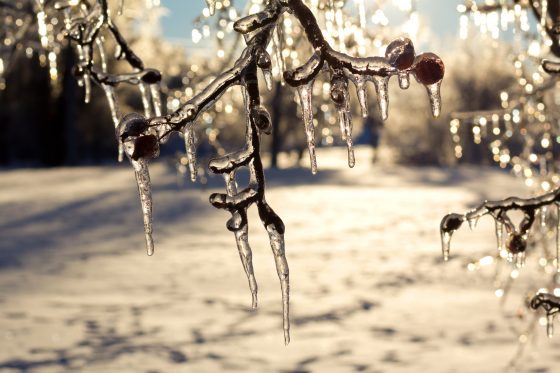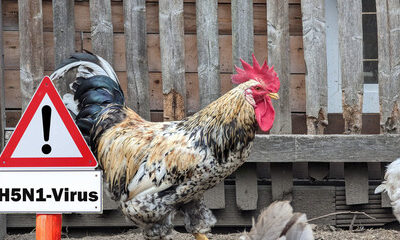This article was originally published by Sara Tipton at Tess Pennington’s ReadyNutrition.com
Tess is the author of The Prepper’s Blueprint: How To Survive ANY Disaster

Layering your clothing is one of the best ways to stay warm. Anyone who works outside or has chores around the house to take care of in the winter months understands the importance of keeping the body warm so it can operate at optimal levels.
Layering your clothing comes with many benefits, including the ability to remove one or two items of clothing if you begin to feel a bit warm and overdressed. This makes you more prepared for any possible weather outcome, writes Mountain Warehouse. When you’re doing a combination of activities such as standing, walking, sitting, going outside and inside and back outside again, your body regulates its temperature very differently. This is ideal for people who do a lot of their chores outdoors! Layering allows you to be comfortable throughout the day as your body temperature and activity level change.
But just how does this technique work to keep a person warm? Layering clothing works by trapping warm air created by your own body heat in between the many layers of clothing. That trapped warm air acts like a layer of insulation for your body. Especially in winter, because that’s when it’s much colder, keeping your core warm is a key to good health, because this is the area that generates heat for your vital organs. Those organs need your body heat to function properly.
The University of Health Services in Madison Wisconsin writes that the basics of layering include four layers.
- Base: a thin layer that fits your body. It works to wick away any sweat and moisture that would otherwise suck up your body heat.
- Mid: your normal outfit, whether that’s a long sleeved shirt or sweater.
- Insulation: keeps your body heat in, and serves as your main source of warmth, like a fleece jacket or down vest. Some parkas even come with a built-in insulation layer.
- Shell: protects you from the elements, like wind, snow, or rain. It’s the last layer of protection between you and Mother Nature.
Some types of materials are more suited for the layering task than others. Try to avoid cotton. It doesn’t insulate well, and when wet causes rapid loss of body heat. And if it’s raining or snowing, don’t put on a down vest or jacket. Once it gets wet, you’ll be very cold.
Let’s start with the “Base layer”. Your base should be able to wick moisture, such as sweat, away. If you are wet, you’ll be cold. A great item for this base piece, I personally have found works wonders, is Under Armor Cold Gear with thumbholes. Click here for a women’s style, and click here for a men’s style. The thumbholes prevent the base layer’s sleeves (which are pretty form-fitting to provide effective moisture wicking) from inching upward throughout activities such as sports or chores where there is a lot of arm movement. The thumb holes are not necessary for everyone, however, I refuse to buy a base layer without them anymore. This layer is going to cost you a little bit, but consider it an investment. Your first and fourth layer will be more expensive to buy, but both will be worth the money. Another perk of buying the Under Armour brand of Cold Gear as your base layer is that their materials are soft, comfortable, and don’t chafe. There are no odd seams in places that could get irritating.
Keep your investment layers from wearing out by using the helpful tips in this article: Follow These Tips If You Want Your Clothes To Last For Years.
The second layer is considered the “mid layer” and should be a regular top. This can be a sweater or a long-sleeved t-shirt if you prefer. It would be the layer you would likely strip down to if you’ll be taking a break from being outdoors and inside for some time, such as coming in for lunch. One thing to consider would be to make sure it feels a little snug and isn’t loose. Also, try to avoid extra fabrics such as ruffles that will make the next two layers more difficult to get on.
The third layer is called the “insulation layer”. This layer should be able to keep your body heat in. This is your main source of heat. A fleece jacket (I have two exactly like this that are my go-to for this layer) or a wool vest work well here. But if you have a sweatshirt or a simple hoodie, that will also do the trick. You won’t need your moisture-wicking here since it’s not against your skin, so throwing on your favorite hoodie will work wonders. This is often where I personally stop my layering for doing sports outside. It works well down to about 25 degrees Fahrenheit (provided you are also wearing a hat that covers your ears and some Cold Gear leggings under sweatpants).
If it’s really cold, or there’s precipitation like snow, you will want the fourth layer which is called the “shell layer.” This layer is what will protect you from wind, snow, and icy rain. This should be waterproof and breathable to allow moisture to escape. Depending on how cold it is, this may only need a rain shell, but a parka would work great too. Consider, like with your base layer, making an investment in your shell because it is going to need to work well for you especially when those temperatures plummet.
*Helpful Hint: Buy base layers and shells during “off seasons” such as the beginning of summer. Often you’ll get those that didn’t sell for about half off! Do this when buying winter boots and gloves too!
Also, don’t forget:
- Get your hands in some gloves or mittens: Hand warmers are also great for keeping your fingers and toes toasty.
- Get your feet in some socks and waterproof boots: Your feet are the farthest from your heart, so they’re the hardest for your body to keep warm. Wool socks are the best material for wicking away moisture and holding in heat. And when you’re boot shopping, look for waterproof and insulated ones (these cannot be beaten and keep your feet warm when temperatures plummet to -30 Fahrenheit) to keep the warmth in and the cold air, mud, and sleet out.
- Hats, headbands earmuffs: You lose the most heat out of your head, not to mention your ears are usually the first parts to freeze since their nerves don’t have much protection.
Tess Pennington is the author of The Prepper’s Blueprint, a comprehensive guide that uses real-life scenarios to help you prepare for any disaster. Because a crisis rarely stops with a triggering event the aftermath can spiral, having the capacity to cripple our normal ways of life. The well-rounded, multi-layered approach outlined in the Blueprint helps you make sense of a wide array of preparedness concepts through easily digestible action items and supply lists.
Tess is also the author of the highly rated Prepper’s Cookbook, which helps you to create a plan for stocking, organizing and maintaining a proper emergency food supply and includes over 300 recipes for nutritious, delicious, life-saving meals.
Visit her website at ReadyNutrition.com for an extensive compilation of free information on preparedness, homesteading, and healthy living.










MYTH: You lose most of your heat through your head.
“The myth is thought to have arisen through a flawed interpretation of a vaguely scientific experiment by the US military in the 1950s. In those studies, volunteers were dressed in Arctic survival suits and exposed to bitterly cold conditions. Because it was the only part of their bodies left uncovered, most of their heat was lost through their heads.
The face, head and chest are more sensitive to changes in temperature than the rest of the body, making it feel as if covering them up does more to prevent heat loss. In fact, covering one part of the body has as much effect as covering any other. If the experiment had been performed with people wearing only swimming trunks, they would have lost no more than 10% of their body heat through their heads, the scientists add.”
ht tps//www.theguardian.com/science/2008/dec/17/medicalresearch-humanbehaviour
<bb
I ONLY COVERED THIS TOPIC TEN YEARS AGO WHEN ALL YOU BOOMERS MADE FUN OF ME FOR BEING “CONCERNED WITH FASHION”
I’M SURE THE UNIVERSITY IN MADISON FUCKING KNOWS MORE THEN I DO. /SARC/
THE BASELAYER INCLUDING SOCKS CAP AND LINER GLOVES IS NEVER ANYTHING BUT MARINO WOOL AS IT IS MUCH WARMER BECAUSE IT ABSORBS SWEAT WHEREAS POLY BASED BASELAYERS DO NOT FUCKING WICK SWEAT THEY JUST SPREAD IT AROUND GET THIS POINT THROUGH YOUR HEADS.
THE FLEECE OR WOOL OR DOWN TOP AND BOTTOM IS THE MIDLAYER
OVER A FLEECE OR WOOL MIDLAYER YOU NEED A NON WATERPROOF, WATER RESISTANT SOFTSHELL OR A WIND SHELL (DOWN CLOTHING IS ALREADY PACKED IN A WINDSHELL). THIS IS WHAT YOU SHOULD BE WEARING 95% OF THE TIME TO BLOCK THE WIND CHILL FACTOR. ONLY WHEN IT IS PRECIPITATING VERY HEAVILY DO YOU NEED A HARDSHELL AS THEY WILL TRAP YOUR SWEAT AND BE VERY UNCOMFORTABLE. WIND SHELLS CAN BE SUBSTITUTED FOR AND ARE MUCH MORE COMFORTABLE THAN RAIN GEAR 95% OF THE TIME BECAUSE THEY BREATHE. I ONLY PUT ON THE HARD SHELL ON MOUNTAIN SUMMITS.
EVERY PREPPER IN HIGH LATITUDES SHOULD ALSO HAVE A DOWN SLEEPING BAG AND A THICK GEL PAD AND A TENT. TURN THE HEAT OFF AND SET UP THE TENT INSIDE A SMALL ROOM. YOU CAN EASILY STAY WARM.
FOR ULTIMATE PEACE OF MIND BUY A HIMALAYAN SUIT FROM EDDIE BAUER, MOUNTAIN HARDWEAR, OR MARMOT. EVERESTGEAR.COM SOMETIMES HAS A SALE ON THEM. IF YOU GET ONE FOR $800 YOU’RE DOING GREAT.
Grandmother from Black Forest said that wool used to be worn, in place of denim. Just-plain pants, and ‘lifetime, 100’s of miles’ shoes, constructed of just-plain, stitched leather, cost several hundreds of dollars, where work clothes are sold. Gloves consisting of durable thickness of garment leather have been spotted at $100+.
Noone would realistically be able to afford peasant stuff, found on an old, German farmstead. People, who have lived here, for several generations, don’t look as good as the ones on the boat to Ellis Island.
If it was like some kid’s play set, for a Christmas gift — like with the milkcows, chickens, and wishing well, exposed beam construction — this is now beyond our capabilities.
Look at the amount of time —
I heard one restorationist, saying the timbers came from 200yr old trees, from the empty lot, adjoining, 200yrs ago. But, the trees would no longer be available, as though there was no deadpan simple way of getting more of those, ever again.
Fashion aside, noone is responsible for sweat or materials. All chiefs, no Indians. Your stuff is becoming more hollow, plastic, made of cardboard, yet everyone has a royal chip on their shoulder.
You would generally not be able to afford a hand-to-mouth existence, under the present, political system, short of being some deeply sold-out cronyist.
But you do feel much warmer when you wear warm head coverings in cool weather.
That, in itself, is a useful result as you can be comfortable at lower temperatures than without it.
FWIW, the head has more cold sensitive areas than the rest of the body as well (i.e. nose, ears, eyes, sinus, etc.) which make them more important than other areas (frostbitten ears are not something to be dealing with in a difficult situation).
yes, you can have everything WELL-COVERED, from neck to toe, and you’ll be miserable if nothing covers the head….and neck….it is VERY important to “have it all”.
In Cold Weather, Cotton Kills.
Put your insulated hat on, to keep your feet warm.
Some things I learned years ago in Boy Scouts from a troop on a military base.
* No 100% cotton anything in the winter. It was referred to as killer cotton. Boys going for an extended trip could not have cotton clothing. The boys who sneaked some favorite cotton item in their pack were observed carefully. We had some who had to leave the festivities early due to this; they learned the hard way.
* Use polypropylene socks under your wool socks. This went for any season. Also, have at least three changes of socks; four is better. Wool socks take three days to dry out after washing and then drying on your backpack.
* Gloves should have a polypropylene liner as well. Two layers are better than one here also.
* If affordable, purchase a 3-in-one jacket. One layer can be a light jacket, one can be a windbreaker, and when zipped together a winter jacket; the shell (windbreaker) often had a hood zipped into the collar to make a second layer for your head. Lots of zippered pockets are also helpful. From a good manufacturer, they wear well and long. I still have one (from scouting days) although one zipper needs replacing and cuffs need some seamstress attention. Yes, they do fade a bit after 25+ years.
* Everyone had hat hair. It got to be a contest who had the worst hair especially in the morning. 😀
There’s more, but these are some highlights. Besides, I think I’ve used up my dime. 🙂
POLYPROPYLENE IS GARBAGE
ONLY EVER USE MARINO WOOL. MUCH SUPERIOR. TRY IT AND TELL ME I’M WRONG.
EVEN IN THE SUMMER MARINO WOOL SOCKS ARE ALL I USE.
Ffffffftttt.!
PFFTTT! x2!
I have to say that I really line Merino wool too. I can’t believe I an agreeing with Eisen….
Unless you go to Alaska or some other exotic place, come on out to the Wind River Mountains of Wyoming and you’ll soon learn what works and what don’t. Wool and Down can’t be beat, Wool is warm and Down is warm and lite. Trekker Out
Down is great lightweight insulation…unless it gets wet. Protect the dryness of your down clothing with your life. Usually Gortex over down works well.
I keep my sleeping bag, socks, winter clothing and down in a rubber waterproof Vietnam era pack liner, inside my pack. They are very cheap on Ebay. Unless it is submerged, everything stays dry.
Mickey Mouse boots with will socks and a sleeping bag are always in my vehicle.
Not everyone can afford wool. That’s my preference as well. But if a person can’t afford a merino wool sock or glove liner, polypro is way better than cotton.
But what the hell do I know! I just a stupid chick!!!!!
well, obviously you know a LOT….thank you for your contributions to shtfplan!
buttcrackofdoom, thanks for noticing. “Eisencrust” seems to like picking on me. Most times I can ignore his comments but now and then it bugs me a lot. I know natural or man-made fibers extremely well like some on here know firearms and can make clothing based on this knowledge. I’ve lived on the trail with my decisions in all seasons as well as daily life; I’m always prepared and comfortable (plus look good).
I lived near Lake Tahoe for two years. I had a pair of military Mickey Mouse boots. Warmest boots I ever owned. My feet never got cold even in subzero temps.
https://www.amazon.com/Extreme-Weather-Waterproof-U-S-Military/dp/B075F7NK51/ref=sr_1_1?s=apparel&ie=UTF8&qid=1542343909&sr=1-1&nodeID=7141123011&psd=1&keywords=mickey+mouse+boots+military
the military has spent MILLIONS in researching how to stay warm and dry…..LISTEN to ’em. great topic, and i’m looking forward to reading the comments section in a couple days…..THIS is why i keep coming back….
military goretex jackets and fleece both have zippers in the armpits, nice if you need a lil ventilation while working/hiking. also, wear a brimmed(baseball cap) hat to keep the parka/goretex hood out of your eyes when raining.
What I find funny is it took the military from 1776 to 2001 to come up with decent general issue cold weather boots and gloves. Sure in Alaska they had mickey mouse boots and arctic mittens but it gets plenty cold in the field at FT Bragg in the winter. It took 9/11 to get good gloves and halfway good boots in every Soldier’s kit.
and that was all about MONEY…..we blow a SHIT-TON of money on keeping them warm, dry, and bulletproof…..and it makes U.S. the best military in the world……consequently, we have available to US the best cold-weather gear. BTW, check out bookoo dot com if you live near a military base. there’s a lot of this gear sold on there. it’s like craigslist for soldiers, but civillians are welcome too….one more hint…if you are FAT, it will be much harder to find your size in military gear, as most soldiers are small or medium when entering, and possibly large by the time they get discharged.
You know what’s really stupid. With all that money they privatized the issue facility and each deployment they issue you new uniforms, gloves, boots etc before you ship out whether you need all of it or not. And then when you get out they have really sstretched the rule that they don’t take things back that touch the skin. When I retired I left with two pairs winter boots, two pairs real expensive winter gloves (one I never used because the first set was still good) two pairs of really expensive goggles, a ton of long underwear and a footlocker of brand new uniforms. They don’t take it back from you so they can keep making and issuing new stuff. I remember in the old days you just kept boots and that was it. To top it off they change the uniform pattern continuously and then make new Rucksacks, body armor shells and LBE with the new pattern each time. That’s why we don’t have enough tanks and ships. They spend all the money on individual gear for the endless war. Don’t get me started on the money they dumped into the MRAP trucks that they had no intention of keeping after the drawdown.
YUP YUP!
When layering, I pay attention to necklines.
If I have a tank top with a scoop neckline, the next piece will be up around the base of the neck, and another that is a turtleneck. I will also layer head coverings.
Ears, nose, and throat: Did you ever notice how when one is infected, they are all infected?
_
Speaking from a construction point of view, I wore insulated bib overalls in winter, felt lined boots, a hooded sweatshirt and a Carharrt chore coat. I can take off the coat and unzip the hoodie or remove it as needed. Any colder than about 25F air temperature and we couldn’t lay brick.
Today, I’m only wearing a sweatshirt and felts to shovel 9 inches of snow. That dang Trump. If it weren’t for him, there’d be a couple illegals out front just begging to shovel my walk. Ouch, my achin’ back…
No cotton? BS. No synthetics, more like! I don’t deal well with cold, and I get far sweatier – then colder – when I layer with synthetics. Why? They don’t “breathe”! My first layer is ALWAYS cotton/cotton blend, then wool socks over the cotton tights and cotton socks, cotton fleece sweat pants over the flannel cotton pj pants over leggings/tights, then my cotton work pants over top of them. Tops, same thing: cotton/cotton blend tank, then snug cotton long-sleeved t, then a sweater and/or hoody, then my winter jacket. I would love to have more wool in my wardrobe, but when you can find it, it’s expensive!
When I went through the Winter Search and Rescue course (I had an Avalanche Dog), they constantly showed us pictures of dead victims. Every time they showed us a picture of a dead person the instructors would point out that the person was wearing cotton. I do not know of any winter back country experts who would ever wear cotton.
For outside chores, shoveling snow, cutting firewood, etc. Cotton is fine because if you get wet, you can just go into your warm house.
There have been many cases of people being stranded in their vehicles in the winter and freezing to death. We always have winter sleeping bags in out car year round. Of course GHB’s in the vehicle as well.
Phoenix, hate to sound like a smart a** but how many layers of cotton does one need in Phoenix, when the temp rarely gets below 70.
I didn’t know cotton was bad to wear in cold weather. I looked it up and here is a very good article that explains why cotton is bad but polyesters and other materials are much better.
Bottom line, cotton holds moisture which drains heat from the body. It makes sense. Live and learn.
https://gizmodo.com/why-cotton-kills-a-technical-explanation-1688286083
there IS another type of longjohns that came along after the polypros. in the army they call them “waffles”. inside-out they look like corduroy. i THINK they are supposed to breathe better, and channel sweat too….i like the polypros best, but if marching/working, they may overheat you more than waffles. i suppose i better try them out to see for myself……
I am not saying that everyone could do that, but where does wool come from, in the first place.
This would be an example of a survival strategy, besides consumerism.
100% of the sheep say, that Wool is the warmest! But most geese seem to think that Down works best. My question is, if down is so bad when wet how come geese like it so well? Trekker Out
Self-Pity
I never saw a wild thing
sorry for itself.
A small bird will drop frozen dead from a bough
without ever having felt sorry for itself.
D. H. Lawrence